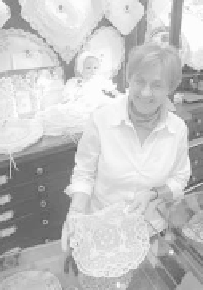Travel Reference
In-Depth Information
Lace
In the 1500s, rich men and women decided that lace collars,
sleeves, headdresses, and veils were fashionable. For the next
200 years, the fashion raged (peaking in about 1700). All this
lace had to be made by hand, and many women earned extra
income from the demand. The French Revolution of 1789 sud-
denly made lace for men undemocratic and unmanly. Then,
in about 1800, machines replaced human
hands, and except for ornamental pieces,
the fashion died out.
These days, handmade lace is usually
also homemade—not produced in facto-
ries, but at home by dedicated, sharp-eyed
hobbyists who love their work. Unlike knit-
ting, it requires total concentration as they
follow intricate patterns. Women create
their own patterns or trace tried-and-true
designs. A piece of lace takes days, not
hours, to make—which is why a handmade
tablecloth can easily sell for €250.
There are two basic kinds of lace:
bobbin lace (which originated in Bruges)
and needle lace. To make bobbin lace, women juggle many
different strands tied to bobbins, “weaving” a design by over-
lapping the threads. Because of the difficulties, the resulting
pattern is usually rather rough and simple compared with
other techniques.
Needle lace is more like sewing—stitching pre-made
bits onto a pattern. For example, the “Renaissance” design is
made by sewing a pre-made ribbon onto a pattern in a fancy
design. This would then be attached as a fringe to a piece of
linen—to make a fancy tablecloth, for instance.
In the “Princess” design, pre-made pieces are stitched
onto a cotton net, making anything from a small doily to a full
wedding veil.
“Rose point”—no longer practiced—used authentic bits
of handmade antique lace as an ornament in a frame or filling
a pendant. Antique pieces can be very expensive.
on lace, the Costume and Lace Museum is a block away and just
around the corner (see page 390).
A block farther down the street, passing the always popular
Waffle Factory (€4, freshly made, take-away, lots of fun toppings)
step into the
Textilux Center
(Rue Lombard 41) for a good look
at Belgian tapestries—both traditional wall-hangings and modern
goods, such as tapestry purses and luggage in traditional designs.
•
Follow the crowds, noticing the excitement build, as in another block
you reach the...




















